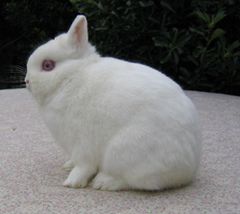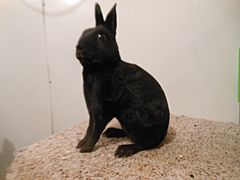Polish rabbit facts for kids
The Polish rabbit is a small, neat breed of domestic rabbit. People often raise them to show them off at rabbit competitions. Even though they are called "Polish" rabbits, they probably first came from England, not Poland. What people in the UK call a Polish rabbit is known as a Britannia Petite in the USA. The rabbit called Polish in the USA is not known by that name in the UK.
Contents
What Polish Rabbits Look Like
Today, Polish rabbits in the USA are popular as show animals and as pets. These rabbits are small. They have short ears that touch each other from the bottom to the top. Their heads are short with full cheeks, and they have bright eyes.
Because they are small, Polish rabbits are sometimes mistaken for Netherland Dwarf rabbits. However, Polish rabbits are a bit bigger. Their heads are not as round as a Netherland Dwarf's. There are also other differences, like their fur, body shape, and colors. A Polish rabbit that is 6 months or older should weigh between 2½ and 3½ pounds. The perfect weight is about 2½ pounds.
Until the 1950s, most Polish rabbits in the USA were white. They either had red eyes or blue eyes. The white rabbits with ruby-red eyes are true albinos. The white rabbits with blue eyes are not true albinos. They have a special white gene from another breed called Vienna.
Since the 1950s, rabbit clubs have started to recognize more colors for Polish rabbits. In 1957, the American Rabbit Breeders' Association approved black and chocolate colors. In 1982, the blue color was recognized. Then, in 1998, the "broken" variety (which means they have patches of color) was approved.
How to Care for a Polish Rabbit
Even though Polish rabbits are small, they need enough space in their cage. They also need to be out of their cage for about 5–6 hours each day. The bottom of their cage should not be slippery. A slippery floor can cause hip injuries or a condition called "splay leg." Cage bottoms should never be made of wire. Wire can hurt their feet and cause bruises.
American Polish rabbits are usually calm and friendly. Male rabbits (bucks) are often very gentle. Female rabbits (does) can be a bit protective of their space if they are not spayed. When children handle rabbits, an adult should always watch. This helps make sure the rabbit is not accidentally hurt.
Rabbits can learn to use a litter box easily. They can also learn to wear a harness and leash when they are outside their cage. It is very important to make a room safe for a rabbit if it is roaming freely. Rabbits love to chew on things like carpets, baseboards, and especially electrical cords.
Feeding Your Rabbit
Polish rabbits should eat about 1/4 cup of rabbit pellets every other day. This amount can change depending on how active your rabbit is.
It is very important that rabbits always have fresh hay. Hay helps keep their teeth healthy. It also helps their stomach and intestines work well. Hay is good for their bladder health and helps control their weight. Plus, it gives them something fun to chew on.
Give treats like fruit and carrots only a little bit. A good size is no bigger than the tip of your thumb. Carrots have a lot of sugar, so it is best to avoid them often. Fresh dandelion leaves, parsley, and spinach are healthy treat choices. You should avoid vegetables from the cabbage family. Also, avoid high-sugar foods like corn. These can cause stomach problems. You should never give seeds to rabbits. Iceberg lettuce has no nutrients. Remember, the darker the lettuce, the healthier it is for your rabbit.
A healthy rabbit should feel solid but not too soft. You can check this by gently running your hand over its back. You should feel a firm layer of flesh over its ribs and spine. You should also be able to feel the ribs and spine themselves. This means your rabbit is eating well. If you feel a very clear spine, your rabbit might not be eating enough. If you cannot feel the spine at all, your rabbit might be eating too much. Adjust their food amount as needed.
Health Concerns
Like other rabbits, Polish rabbits do not do well in very hot weather. However, they can handle cold temperatures if they stay dry and out of drafts. They can get hairballs if they are not groomed properly. Their fur can also get matted.
Other health problems can include ear mites and breathing issues. They can also have dental problems, bladder stones, and broken backs. If you notice any changes in how much your rabbit eats or its litter box habits, contact a rabbit veterinarian right away.
A Polish rabbit that is used for breeding usually lives for 5 to 6 years. If they are spayed or neutered, they can live longer, often 8 to 10 years.
See also
 In Spanish: Conejo polaco para niños
In Spanish: Conejo polaco para niños




